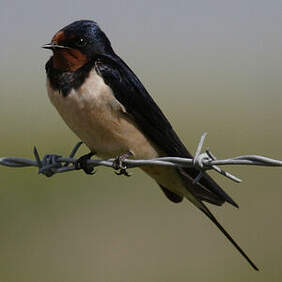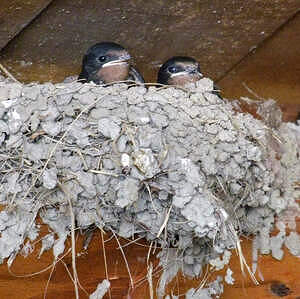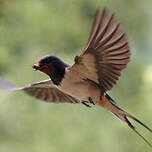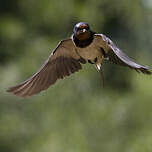Barn Swallow
Hirundo rustica - Hirondelle rustique Hirondelle de cheminée
Identification
With its slim body, scythe-like wings, forked tail and wide distribution, the Barn Swallow can be taken as a model of the Hirundinidae family. The adult in nuptial plumage has a glossy black top and wings with a bluish tint in the right light. Flight feathers and rectrices are darker and without any reflections. In the subspecies rustica, the underside of the body is white with a creamy tint. The head shows typical brick-coloured forehead and throat. Its black sides encircle the throat, include the dark eye and extend into a more or less regular blackish-brown breastband that may include some brown feathers. The tail is blackish with a large white subterminal patch. Their length increases slightly from the inside to the outside, giving a forked look. The external rectrices are long and thin forming two narrow streamers. The small but wide black beak gives way to a wide mouth cavity. The very short legs are blackish. The sexual dimorphism is very slight. The adult female can be distinguished from the male by its shorter streamers and slightly duller plumage. The juvenile can be identified by its pinkish-fawn forehead and throat and its lack of tail streamers. The species cannot be confused with another swallow in most of its range. In South-East Asia, take extra caution for the somewhat similar Tahiti Swallow, and also to a lesser extent the Long-tailed Swallow. In Africa where it winters, however, 3 or 4 species present some similarities. The 8 described subspecies differ from one another by the colour of the underneath, which can go to reddish-brown, for example in the American erythrogaster subspecies or savignii from Egypt.The importance of the breast band also varies greatly depending on the subspecies. It narrows from west to east and can go up to an incomplete band, with only a sketch on the sides of the chest as in the eastern Russia ssp saturata of the Barn Swallow.
Subspecific information 8 subspecies
- Hirundo rustica rustica (Europe, w and c Asia and n Africa)
- Hirundo rustica savignii (Egypt)
- Hirundo rustica transitiva (Lebanon, Syria, Israel and Jordan)
- Hirundo rustica tytleri (sc Siberia)
- Hirundo rustica gutturalis (e Himalayas to Korea and Japan, e and s China and Taiwan)
- Hirundo rustica saturata (e Siberia)
- Hirundo rustica mandschurica (ne China)
- Hirundo rustica erythrogaster (Alaska, Canada and the USA to s Mexico)
Foreign names
- Hirondelle rustique,
- Golondrina común,
- andorinha-das-chaminés,
- Rauchschwalbe,
- füsti fecske,
- Boerenzwaluw,
- Rondine,
- ladusvala,
- Låvesvale,
- lastovička obyčajná,
- vlaštovka obecná,
- Landsvale,
- haarapääsky,
- Europese Swael,
- oreneta comuna,
- Landsvala,
- dymówka,
- bezdelīga,
- kmečka lastovka,
- Деревенская ласточка,
- Layang-layang api,
- ツバメ,
- 家燕,
- นกนางแอ่นบ้าน,
- 家燕,
Voice song and call
The usual call is a vit or uit, often given while flying. It can be repeated or linked together in short phrases such as tsi di dit or si si sit during interactions. The alarm call is an energetic tsivitt repeated while danger persists. The song is a long, harsh but quite melodious warbling sound, containing the tonality of the calls and ending with a drawn-out trill.
Habitat
The Barn Swallow needs open spaces such as farmland and wetlands for its food, usually at altitudes lower than 1000 meters, but locally up to 3000 m.
Behaviour character trait
The Barn Swallow is an anthropophilic species that does not fear humans and nests in its proximity, often immediately.
It is a gregarious species that can gather in large numbers during the nonbreeding season, but it cannot be considered a social species. It does not nest colonially and in groups, individuals keep a distance 15 cm apart from each other. Most Barn Swallows are migratory and spend the winter in tropical or equatorial environments. The return of Western European birds begins in mid-March and continues into April. The male usually arrives first and its song signals its return. The nesting territory is reoccupied without delay. At the end of the season, the postnuptial gatherings on the wires, very visible in villages, presage the departure in migration which takes place in September and continues into early October. One can try to attract a Barn Swallow couple to the countryside. All that is needed is a quiet space, such as a garage or storeroom with permanent access (skylight, manhole, etc.) allowing visits and support for the nest, with ceiling beams being ideal. It is best not to have a cat in the house. If you are lucky enough to attract a couple to your home, you will not tire of observing the behaviour of the birds. As Barn Swallows need damp soil to build the nest, they can be favoured by providing small muddy puddles in an open environment. However, there will be little that can be done for them in the event of prolonged bad weather that prevents them from feeding normally and can lead to increased mortality of young in the nest and of adults.Flight
Barn Swallows are morphologically adapted to the aerial environment in which they find their food. Their long and narrow wings allow them to have a sustained flight, including long distances since many of them are migratory, as well as great agility in the air, for example when they hunt for flying insects.
However, hovering in the air is not allowed for them. The flight of the Barn Swallow follows this overall scheme. Its flight is easy, with a rather slow but steady flapping for the size of the bird. The bird alternates between flapping and gliding phases. It swerves, turns on its wings, dives or takes off in pursuit of insects. To drink, it slides, wings raised, above the water surface which it brushes with its beak, like swifts also do. When it has landed on the ground, especially when it collects mud for the nest, its take-off is somewhat laborious, hampered by its long wings and short legs.Dietfeeding habits
The Barn Swallow, like all members of its family, is an exclusive insectivore, only feeding on insects caught while flying.
It is morphologically adapted to this function. Vision plays a major role in hunting. Prey is recruited from more than 80 families of insects, Dipterans always coming first in number. Of course the diet varies according to location, seasons and even years. During periods of cold and unfavorable weather for insects, swallows hunt preferentially above water, where the entomofauna is more abundant. When hunting to feed its nestlings, the swallow stores several prey in its mouth to avoid making multiple trips. A swallow can contain around twenty insects. Despite this, the trips of the parents can still be repeated nearly 400 times a day.Reproduction nesting
The Barn Swallow prefers to build its nest in stables, barns and other such structures, ideally with a beam ceiling. Alternatively, it can nest in any sheltered location (such as garages, cellars, sheds, verandas, etc.) provided there is permanent access. The nest is made by the female, using mud collected from the edge of water which she forms into pellets, giving the nest a unique granulated look. She adds twigs to maintain stability and cohesion. It is a permanent nest that can be reused for several years. It has a half-cup shape depending on where it is built; when against a beam it can reach up to 2cm wide and 1cm tall. There is no distinct entryway and the nest is always very close to the ceiling for added protection. The inside is lined with dry grass and feathers. An analysis of a nest revealed it was made up of 212g of dry earth and 2,224 rootlets and more than 1,100 trips were required to build it (La Hulotte n°60, pp 12-17). Interestingly, there have been reported cases of Barn Swallows collecting fur from cats to line the nest. When the weather is favorable, it takes about eight days for the nest to be completed. Adults prefer to reinforce existing nests than build a new one, leading to competition for the best nests at the start of the season.
It is not uncommon for other species such as the Common House Sparrow, Common Blackbird, Grey Wagtail or Wren to take over the nest.The Sparrow is the most annoying as it is able to expel its rightful owners. The first broods occur from late April to June. In our temperate regions, this may be followed by a second clutch, more rarely a third. Cases of four successive clutches are cited in the literature. The nesting period ranges from April to August. The female lays 2 to 7 eggs, usually 4 or 5, pinkish white and speckled with brown, which she will brood almost alone for 13 to 16 days. She leaves briefly to go and feed herself. Brooding also allows thermoregulation of the eggs when the nest is exposed to high temperatures, for example in an agricultural hangar in sheet metal. The young stay in the nest for about 3 weeks. Their weight will peak at 22 grams, 5 grams more than the parents, at 13 days. This excess weight will be quickly lost afterwards, especially due to the growth of the plumage and flight. Around the fifteenth day, when the feathers are developed enough to keep body heat, the parents no longer shelter them during the night, and only intermittently during the day. Then around the 20th day, the parents will stop feeding them in the nest. To force them to leave the nest and take flight, they approach them with insects but without giving them. Driven by hunger and forced by the cries of adults, the young will eventually throw themselves into the void, the flight being instinctive in them. Although the parents evacuate the fecal sacs of their young, the edge of the nest is filled with droppings as the breeding progresses and many of them fall to the ground below. It is this dirty side of the nest that puts off some people who for that reason don't accept Barn Swallow in their home. Quickly, the couple can start a second nest if conditions allow, the male taking charge of feeding the juveniles from the first clutch until their emancipation around the 35th day of life.All nesting is not successful. It is common for a clutch or a hatch to be lost. Infertile, infecund, or unfertilized eggs are common among passerines. A survey conducted in the 1970s and 1980s in Moselle (J. Meguin, private communication) can help us understand. In 1978, a fairly high mortality rate was noted at the egg stage. It affected 51 broods out of 608, or 8.5% of them, including 21 complete abandonments. In 1980, the proportion was 12%. As for the clutches, their survival depends on the weather conditions that influence the frequency and quality of feeding. In 1978, 32 clutches out of 608 totaling 87 nestlings were found dead. It was observed that when the search for food is made difficult, adults manage to feed the nestlings as best they can until their tenth day, but beyond that age, young ones eventually die of malnutrition, not having the necessary amount of food for their growth.Geographic range
The Barn Swallow is widely distributed across North America and Eurasia. Its range is centered in the temperate zones of both continents, with a spillover into boreal zones in the north and subtropical climates such as the Mediterranean in the south. In Africa, it only breeds in the far north, in the Maghreb, northern Libya, and in the Nile Valley of Egypt. The wintering areas are almost completely separate from the breeding areas. North American birds go to South America for the winter. European birds go to Africa, and those from northern Asia winter in the Indian subcontinent or Southeast Asia. Regarding European birds, only a small wintering is known in the south of Spain.
Threats - protection
IUCN conservation status
concern
in the Wild
threatened
evaluated
The Barn Swallow is a common species, currently not globally threatened. However, a fairly marked decline has been noted since the end of the 20th century in Western Europe, for multiple reasons. Its dependence on human habitats makes it vulnerable. For example, the disappearance of traditional stables and barns deprives it of its traditional nesting sites. The profound modification of the agricultural environment due to the modernization of agriculture and the intensive use of all kinds of pesticides deprives it of its resources. There is substantial evidence of the rarefaction of the global entomofauna and a unprecedented loss of diversity, to the detriment of the species.
Sources of information
- IOC World Bird List (v15.1), Gill, F and D Donsker (Eds). 2025-12-07.
- Wikipédia, Wikipedia, The Free Encyclopedia
- Vol. 9 - Handbook of the Birds of the world, Josep del Hoyo - Andrew Elliot - David Christie
- Swallows and Martins, Angela Turner
- Birds of the World, The Cornell Lab of Ornithology
- xeno-canto, Sharing bird sounds from around the world,
Other sources of interest
 Specification sheet created on
16/07/2023 by Jean François
Specification sheet created on
16/07/2023 by Jean FrançoisTranslation by AI Oiseaux.net
© 1996-2025 Oiseaux.net
- Accipitriformes
- Aegotheliformes
- Anseriformes
- Apodiformes
- Apterygiformes
- Bucerotiformes
- Caprimulgiformes
- Cariamiformes
- Casuariiformes
- Charadriiformes
- Ciconiiformes
- Coliiformes
- Columbiformes
- Coraciiformes
- Cuculiformes
- Eurypygiformes
- Falconiformes
- Galliformes
- Gaviiformes
- Gruiformes
- Leptosomiformes
- Mesitornithiformes
- Musophagiformes
- Nyctibiiformes
- Opisthocomiformes
- Otidiformes
- Passeriformes
- Pelecaniformes
- Phaethontiformes
- Phoenicopteriformes
- Piciformes
- Podargiformes
- Podicipediformes
- Procellariiformes
- Psittaciformes
- Pterocliformes
- Rheiformes
- Sphenisciformes
- Steatornithiformes
- Strigiformes
- Struthioniformes
- Suliformes
- Tinamiformes
- Trogoniformes


































